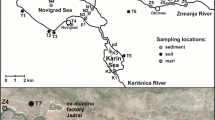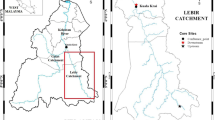Abstract
Purpose
This study used multi-element signatures of stream sediments to assess both natural and human-induced impact on fluvial system in the River Neretva delta receiving environment over time. The river basin actually comprises several sub-catchments, and the geochemical features of major elements, trace metals radiometric and mineralogical characterisation of river bed sediments were used to assist the interpretation of the environment of deposition and its subsequent modifications caused by various anthropogenic pressures within the river basin.
Materials and methods
Five sites were chosen for sediment sampling at key locations within the study area with assumed undisturbed, continuous sedimentation process. At each of the sites, three representative cores were taken by scuba divers. Sample sites were selected in order to reflect the influence of different sub-catchments they belong to and the land-use pattern of the surrounding area. Samples were analysed for pH, redox-potential, granulometry, mineralogy, thermogravimetry, major and trace element concentrations and radionuclide activities. The univariate and multivariate statistics were applied. The geochemical normalisation of data was done using Al, the procedure based on calculation of the regression line of the metal on the normaliser followed by testing the ratios metal/normaliser on all data-points.
Results and discussion
All studied sediments are classified as silt, ranging from clayey silt to silt and sandy silt. Mineralogically, the sediments were dominated by carbonates and quartz. The chemical contaminant data are generally of good quality, mostly below guideline levels. Sedimentation rates were estimated using vertical distribution of 137Cs activities. Normalisation of TMs done by using Al shows strong R 2 adj values for the regressions of Al and V, Al and Cr, and Al and Ni. However, Al cannot fairly explain the fluctuation of the concentrations of Cd, Cu, Pb and Zn in sediment cores from all of the sampling sites. Generally, inorganic scavengers such as clay minerals followed by Fe and Mn oxides and S (pyrite and gypsum) seem to be dominant factors controlling TMs in studied sediments.
Conclusions
Although the River Neretva delta occupies a rather small area, the geochemical features of major and trace elements and 137Cs activities show complex sediment provenances. Each of the sampling sites reflect exactly different effects of anthropogenic intervention that particularly refer to the changes in river morphology and ecology, along with the altered flow regimes within the catchment on sediment loads and quality.






Similar content being viewed by others
References
Alloway BJ (ed) (2013) Heavy metals in soils: trace metals and metalloids in soils and their bioavailability. Environmental Pollution 22. Springer Science + Business Media Dordrecht
Aloupi M, Angelidis MO (2001) Normalization to lithium for the assessment of metal contamination on coastal sediment cores from the Aegean Sea, Greece. Mar Environ Res 52:1–12
Audry S, Schäfer J, Blanc G, Jouanneau J-M (2004) Fifty-year sedimentary record of heavy metal pollution (Cd, Zn, Cu, Pb) in the Lot River reservoirs (France). Environ Pollut 132:413–426
CCME (2003) Sediment quality guidelines for the protection of aquatic life. Freshwater and marine ISQG/PEL. Canadian environmental quality guidelines. Canadian Council of Ministers of the Environment, Winnipeg
Covelli S, Fontolan G (1997) Application of a normalization procedure in determining regional geochemical baselines. Environ Geol 30(1/2):34–45
Croatian Official Gazette (2014) Regulation on protection of agricultural land in the Republic of Croatia. Government of the Republic of Croatia Zagreb, 9/14
Cukrov N, Mlakar M, Cuculic V, Barisic D (2009) Origin and transport of U-238 and Ra-226 in riverine, estuarine and marine sediments of the Krka River, Croatia. J Environ Radioactiv 100:497–504
Cukrov N, Franciskovic-Bilinski S, Barisic D, Hlaca B (2011) A recent history of metal accumulation in the sediments of Rijeka harbor, Adriatic Sea, Croatia. Marine Poll Bull 62:154
Dhivert E, Grosbois C, Rodrigues S, Desmet M (2015) Influence of fluvial environments on sediment archiving processes and temporal pollutant dynamics (Upper Loire River, France). Sci Tot Environt 505:121–136
Dinelli E, Cortecci G, Lucchini F, Zantedeschi E (2005) Sources of major and trace elements in the stream sediments of the Arno river catchment (northern Tuscany, Italy). Geochem J 39(6):531–545
Fay D, Zhang C (2007) “Towards a National Soil Database”. Associated datasets and digitial information objects connected to this resource are available at: Secure Archive For Environmental Research Data (SAFER) managed by Environmental Protection Agency Ireland. http://erc.epa.ie/safer/resource?id=c265bb3f-2cec-102a-b1da-b128b41032cc
Halamic J, Miko S (eds) (2009) Geochemical atlas of the republic of Croatia. Croatian Geological Survey, Zagreb
Helz CR, Miller CV, Charnock JM, Mosselmans JFW, Pattrick RAD, Garner CD, Vaughan DJ (1996) Mechanism of molybdenum removal from the sea and its concentration in black shales: EXAF evidence. Geochim Cosmochim Acta 60:3631–3642
HR ISO 16772 (2009) Soil quality – Determination of mercury in aqua regia soil extracts with cold-vapour atomic spectrometry or cold-vapour atomic fluorescence spectrometry. Croatian Standrad Institute
HRN ISO 11466 (2004) Soil quality – Extraction of trace elements soluble in aqua regia. International standard. Zagreb, Croatia. Croatian Standards Institute
Kovacevic Galovic E, Ilijanic N, Peh Z, Miko S, Hasan O (2012) Geochemical discrimination of early Palaeogene bauxites in Croatia. Geol Croat 65(1):53–65
Ladd SC, Marcus WA, Cherry S (1998) Differences in trace metal concentrations among fluvial morphologic units and implications for sampling. Environ Geol 36(3–4):259–270
Mil-Homens M, Vale C, Raimundo J, Pereira P, Brito P, Caetano M (2014) Major factors influencing the elemental composition of surface estuarine sediments: the case of 15 estuaries in Portugal. Mar Pollut Bull 84:135–146
Morse JW, Luther GW (1999) Chemical influences on trace metal-sulfide interactions in anoxic sediments. Geochim Cosmochim Acta 63:3373–3378
Norris RS, Arkin WM (1998) Known nuclear tests worldwide, 1945-98. Nuclear Notebook. B Atom Sci 54(6):65--67
Owens PN, Batalla RJ, Collins AJ, Gomez B, Hicks DM, Horowitz AJ, Kondolf GM, Marden M, Page MJ, Peacock DH, Petticrew EL, Salomons W, Trustrum NA (2005) Fine-grained sediment in river systems: environmental significance and management issues. River Res Applic 21:639–717
Pamic J, Tomljenovic B, Balen D (2002) Geodynamic and petrogenesis evolution of Alpine ophiolites from central and NW Dinarides; an overview. Lithos 65:113–142
Romic M (2012) Bioavailability of trace metals in terrestrial environment: methodological issues. European Chemical Bulletin 1(11):489–493
Romic M, Romic D (2003) Heavy metals distribution in agricultural topsoils in urban area. Environ Geol 43(7):795–805
Romic D, Romic M, Zovko M, Bakic H, Ondrasek G (2012) Trace metals in the coastal soils developed from estuarine floodplain sediments in the Croatian Mediterranean region. Environ Geochem Health 34(4):399–416
Romic M, Matijevic L, Bakic H, RomicD (2014) Copper accumulation in vineyard soils: distribution, fractionation and bioavailability assessment, environmental risk assessment of soil contamination. In: Hernandez Soriano MC (ed) Tech Rijeka. Available from: http://www.intechopen.com/books/environmental-risk-assessment-of-soil-contamination/copper-accumulation-in-vineyard-soils-distribution-fractionation-and-bioavailability-assessment
Sakac K, Sinkovec B (1991) The bauxites of the Dinarides. Travaux 23:1–12
SAS Institute (2004) SAS/STAT® 9.1 user’s guide. SAS Institute Inc, Cary
Schropp SJ, Lewis FG, Windom HL, Ryan JD, Calder FD, Burney LC (1990) Interpretation of metal concentrations in estuarine sediments of Florida using aluminium as a reference element. Estuaries 13:227–235
Senesi N, Sposito G, Holtzclaw KM, Bradford GR (1989) Chemical properties of metal-humic acid fractions of a sewage sludgeamended aridisol. J Environ Qual 18:186–194
Shepard FP (1954) Nomenclature based on sand-silt-clay ratios. J Sediment Petrol 24:151–158
Simpson SL, Batley GE, Chariton AA, Strauber JL, King CK, Chapman JC, Hyne RV, Gale SA, Roach AC, Maher WA (2005) Handbook for sediment quality assessment. CSIRO, Bangor
Sliskovis I, Kapelj J, Kapelj S (1998) Hydrogeological conditions and the necessity for sanitary protection of the Norinska River - Prud spring, Metkovic, Croatia. Geol Croat 51(1):91–103
Suh JY, Birch GF (2005) Use of grain-size and elemental normalization in the interpretation of trace metal concentrations in soils of the reclaimed area adjoining Port Jackson, Sydney, Australia. Water Air Soil Poll 160:357–371
Vranjes M, Vidos D, Glavas B (2007) Status of sediments in the lower Neretva River. Proceedings of the 4th Croatian Conference on Water: Croatian Waters and European Union – Challenges and Possibilities. Ed. Gereš D. Opatija, Croatia, May, 17–19, pp 337–344
VROM (2000) Target values and intervention values soil sanitation. Circular DBO/1999226863, 4-2-2000
Wedepohl KH (1995) The composition of the continental crust. Geochim Cosmochim Ac 59(7):1217–1232
Acknowledgments
This study was supported by Croatian Waters (Hrvatske vode dd), project “Physical-chemical and geological characterisation of River Neretva sediment”, contract number 03-5007/1-2009, and The Ministry of Science, Education and Sports of the Republic of Croatia, projects 178-1782221-2039 and 178-1782221-0350. Their support is greatly appreciated.
Author information
Authors and Affiliations
Corresponding author
Additional information
Responsible editor: Jaume Bech
Rights and permissions
About this article
Cite this article
Kralj, D., Romic, D., Romic, M. et al. Geochemistry of stream sediments within the reclaimed coastal floodplain as indicator of anthropogenic impact (River Neretva, Croatia). J Soils Sediments 16, 1150–1167 (2016). https://doi.org/10.1007/s11368-015-1194-3
Received:
Accepted:
Published:
Issue Date:
DOI: https://doi.org/10.1007/s11368-015-1194-3




